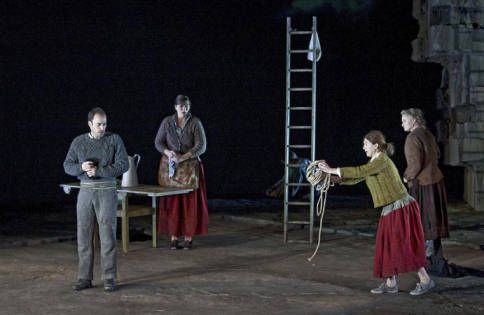Other Links
Editorial Board
- Editor - Bill Kenny
Founder - Len Mullenger
Google Site Search
SEEN
AND HEARD OPERA REVIEW
Vaughan Williams, Riders to the Sea,
Sibelius, Luonnotar: Soloists,
Orchestra of the English National Opera, cond. Edward Gardner. Dir.
Fiona Shaw. English National Opera at the London Coliseum, 27.
11.2008 (ME)
‘Th’ whole world’s in a terrible state o’ chassis’ - (O’Casey) so it
is, to be sure, and this sombre piece based on Synge’s gloomy tale
of a mother who loses her entire male family to the sea, serves as a
bracing corrective to our consumerist woes. Synge spent some time in
the Aran Islands, and their bleak terrain, subsistence lifestyle and
stark beauty had a strong impact upon him (though not so strong as
to prevent him from going back to civilization, like any sensible
man.) Yeats characterized Synge as a man who ‘dying, chose the
living world for text’ and who had found, in the Aran Isles, ‘a race
/ Passionate and simple like his heart’ – the passion and simplicity
of the islanders is at the core of the story, as of course is death,
and there is no temporal redemption either in the text or the
music, with Maurya’s final ‘No man at all can be living for ever,
and we must be satisfied’ as near as it gets to consolation.

A well known
conductor once amused me by his colourful reaction to being told
‘We’re having someone to direct who is an ACTOR - never done an
opera before, doesn’t even like opera! Won’t that be EXCITING?’
Well, no..it won’t.’ Here we had Fiona Shaw, the professional Irish
actress (as in, professional Geordie) having a perfectly decent go
at opera direction…I have to ask, why? Does one have to be Greek,
say, to have a stab (sorry) at ‘Orestes?’ Luvvies were everywhere of
course, and an added poignancy was to be had from the recent death
of the scheduled conductor, Richard Hickox – but not to worry, Ed
Gardner stepped in and galvanized the orchestra into a terrific
performance.
I love RVW -
no, really – but can well understand why this work has remained
relatively underexposed. It has echoes of Pelléas et Mélisande
in parts, and the music of the sea is often wonderfully evocative,
as you would expect from this composer, but the work as a whole has
the feeling of an excerpt, with the characters only sketchily known.
The Mother has already lost five sons, her husband and father-in law
to the sea, and is soon to lose her last son, leaving just the two
‘gerruls’ at home to keen over the pots. Shaw and her designers,
Dorothy Cross and Tom Pye, have created a bleak setting of sparse
domesticity, drawing strongly upon archive photographs, and the
singers are given plenty of room both musically and dramatically.
The performances are uniformly strong – Patricia Bardon moving as
the old woman, Leigh Melrose making the most of the rather
ungrateful role of Bartley, and Kate Valentine and Claire Booth as
the daughters.
The task of
evoking the elemental quality of the landscape and sea is given
mostly to the orchestra, and here the intensive preparation by
Richard Hickox and the sympathetic advocacy of Edward Gardner create
a swirling, uncertain world in this work where it is often difficult
to make out a key-centre. There is a philosophical and tonal link to
some of Sibelius’ work – the two composers admired each other, and
so it was particularly apt to pair ‘Riders’ with Luonnotar,
sung with glowing tone and ecstatic commitment by Susan Gritton –
this work, with its suggestions of the Liebestod is linked to
the Vaughan Williams not only by its elemental themes but its use of
the voice, and it cannot be easy to perform in a production where
you are precariously perched on a suspended boat.
A brief
evening – just about an hour in all, but extremely intense, and
illuminating in that the two works are not only infrequently
performed but were here linked finely via incidental music by John
Woolrich and video images created by Dorothy Cross, the ‘Worm Hole’
sequence being especially vivid. These may not be amongst the most
popular works in the operatic canon, but it is part of ENO’s remit
to explore the unusual and striking, and this is all the more
praiseworthy when the work is a neglected one by a great British
composer.
Melanie Eskenazi
Picture © Clive Barda
Back
to Top
Cumulative Index Page
